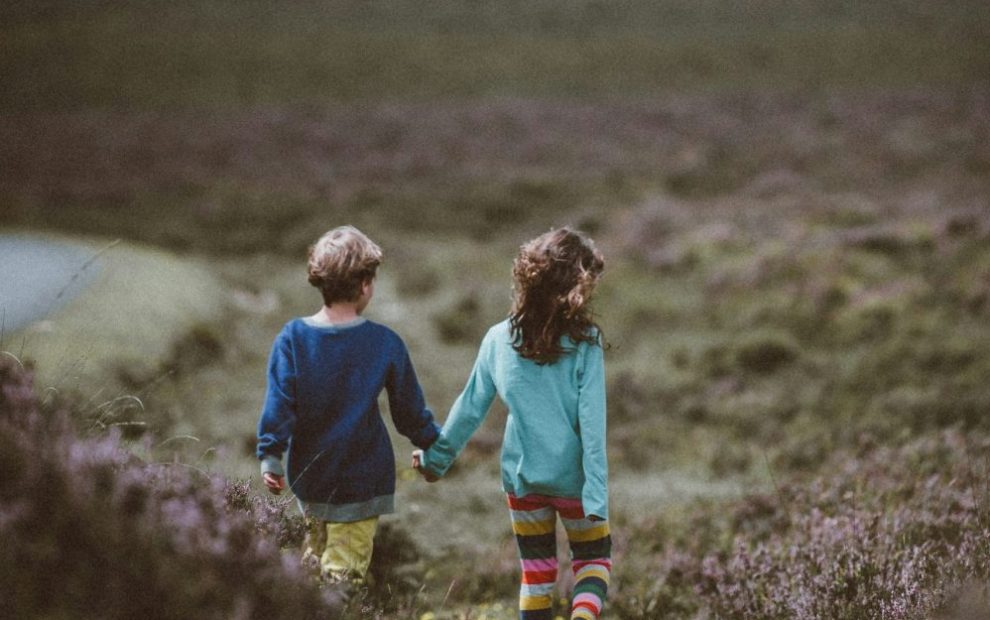
“I grew up with a version of Christianity, God, and the Bible that was, in my experience, often used to control children or to abuse and neglect them,” says Ryan Stollar, an advocate for children and abuse survivors and author of a new book, The Kingdom of Children (Eerdmans). “I grew up in a conservative evangelical home and was homeschooled from kindergarten through high school graduation. And while my homeschooling experience was generally positive, I saw a lot of abuse and neglect among my peers.”
As an adult, Stollar created a website and organization called Homeschoolers Anonymous that allows people who grew up within that same homeschooling world to tell their stories and connect with others. He realized he needed to be better equipped to do that work, so he got a master’s degree in child protection.
“Getting that degree, I was constantly confronted with that fact that so much of what I grew up being taught were best practices for raising and interacting with children was diametrically opposed to actual best practices in child protection and advocacy,” he says.
Stollar realized that there had to be a different way of talking about children in Christianity that ensures the church empowers children instead of harming them. “This book is my attempt to explore how Christianity can be used in a way to empower and liberate children,” he says. The Kingdom of Children proposes a theology that centers children in theology, scripture, and church life, asserting that children can be theologians in their own rights and take an active role in their own faith lives.
What is an example of how we overlook children in even the most familiar scripture stories?
Any time you have a community or group of adults, you will have children. These are what I call the unseen children of the Bible; they’re all over scripture when you start thinking about it. The first part of really recognizing children in the Bible is to start thinking about where they would be alongside adults. For example, children would have been in the cities of Sodom and Gomorrah when they were destroyed. We know there are children there, because Lot was there with his daughters. The same is true in the story of Noah’s flood: We know that adults perished in the flood, therefore there must have been children who died as well.
When we read these stories, even when children are not specifically mentioned, we should be thinking about whether there were children around and how that impacts the story and how we interpret it.
Another example is when stories do directly mention children: These are Bible stories where we can challenge ourselves to truly center children and think about the story through their eyes. One example of a story like this is Elisha and the children who make fun of his baldness, after which he sends a bear to maul the children.
Growing up, I always heard that the children did something wrong. Elisha had the power of God behind him, it seems. He summons the bear. He’s an adult, and the children are the ones punished. I always heard that the children were provoking Elisha, and Elisha responded in an act of righteousness to punish them.
Jewish people have a very different take on this story: The Talmud says that God actually punishes Elisha for letting his anger get the better of him. This perspective helps us rethink the whole story and put children at the center. If we see Elisha as the one in the wrong, then we can reject all the different ways the story has been used to justify why the children should have been harmed or punished. Instead, we can see that the story is about an adult who lets his anger lead to the abuse of children, which is a very different take. It’s not a story about how children should behave and respect authority; it’s a story warning us that even a prophet of God is capable of harming children.
How do you talk about these types of horrific stories with children?
It’s always a question at what stage it is appropriate to pass these stories on to children. How can you simplify and summarize this story or message in a way that is protective of children as opposed to traumatizing them?
This is a challenging question, and it’s not just about the Bible. How do you talk to your children about what’s going on in Gaza right now? How do you talk to them about the basics of consent and sex education and communicating to them that there are people out there who want to prey on them? It’s a very tricky thing.
When it comes to some of these more disturbing stories in the Bible, what we should be focusing on first and foremost is how to teach them in a way that is protective of children. If we are telling children the story of Elisha and the bear, for example, I would focus on the fact that Elisha is wrong, even though he is a prophet of God. That’s an important lesson, because so much of our world says that you shouldn’t question authority figures. And in that world, the lesson that even God’s anointed can be in the wrong is something that can keep them safe from predators.
Children are often taught that the Bible says to obey your parents and God. But you argue that there are places in scripture where kids are encouraged to talk back or question authority. Can you give an example?
There’s a passage in Ezekiel where God is talking to the children of Israel—as opposed to their parents. God specifically says something like, “Do not obey your parents. I am the Lord your God. Obey my commands.”
That verse really stands out to me, because I was taught so many times about the verse from Ephesians and Colossians: “Obey your parents, for this is right.” And yet there’s this verse elsewhere in the Bible that’s specifically saying that if your parents are telling you to do things that are wrong, then you have been given not just the freedom to disobey but the command to disobey. That’s something that’s really important and not often thought about in faith communities.
I think we often assume that children know how to disobey: It comes naturally to them because they are somehow sinful or evil. So we focus instead on teaching them to obey. But disobedience, even appropriate disobedience, can actually be a really significant challenge for many people—not just children. The ability to disobey an authority figure when that person is telling you to do something wrong—that takes a certain muscle that needs to be strengthened through practice. It doesn’t come naturally to a lot of people. A lot of people are raised to be fearful of disobeying, and so when that moment happens, it’s a challenge to stand up for themselves and go against the flow or be an active bystander.
I think it’s important to create space for children not just to know that disobedience can be good and holy, but also to give them opportunities to practice this. This is something that can be done in families: You can talk about this as a way to protect them from abuse. What would you do if someone touched you in a way that made you uncomfortable? What would you tell another adult if you were going through something like that? Practicing that so they don’t just freeze can be so protective. It could be done at church too—letting children roleplay different situations where they encounter someone telling them to do something that is wrong. It’s important to encourage children to think about how to speak up and how they would protest or do whatever they need to do to keep themselves safe.
We can’t talk about children in the Bible without mentioning Jesus. What do we know about how Mary and Joseph parented Jesus?
First, we know that Jesus needed parenting. He was fully human, and all human children require parenting or they will suffer really detrimental effects. If Jesus had just been put in a crib and completely ignored, he would have died. Infants need human interaction to thrive and survive.
Jesus was not unique in needing the things that all children need. We also know that he grew over time; there’s the story in the gospels where he was with the rabbis for several days, and Mary and Joseph couldn’t find him. The end of the passage says that “Jesus grew in wisdom”—he was developing as a human being, just as all children do.
The fact that Jesus grew up to become an adult indicates he was parented, but the type of human he became—the way he interacted and treated those around him—also indicates that he was parented in a certain way. He learned very healthy things like compassion, empathy, and about injustice. He had very little patience for injustice.
Did toddler Jesus ever have temper tantrums?
I grew up being taught that many behaviors were sinful when actually they are just normal parts of child development. A temper tantrum is one of these behaviors. But a tantrum is just a wave of emotional dysregulation. Every child is born with a prefrontal cortex that needs to develop; they’re not born with perfect self-regulation. Scientifically, a tantrum is when a child has emotions that are stronger than the skills they have currently developed to regulate themselves, and they get overwhelmed.
That is a normal part of child development, and therefore I argue that yes, Jesus would have to go through tantrums to learn how to regulate his emotions. How you learn is in these moments when you get overwhelmed and your parent says, “Here, let me give you these skills so you know how to avoid this in the future.” If Jesus had no tantrums, he wouldn’t have learned.
It’s the same with things like learning to share: These are all part of growing up and learning. This behavior isn’t willful or selfish or evil of children—there are legitimate reasons behind why children act the way they act. We know that Jesus felt frustration when he was an adult, so it makes sense that he needed to learn how to regulate that emotion.
Switching gears a bit, your book works on developing a liberation theology for children. Why do children need a liberation theology?
Our world in general is very anti-child. The United States is the only member of the United Nations that has not ratified the UN Convention on the Rights of the Child. The majority of states have religious exemptions for parents who abuse or neglect their children. For example, if you deny your child lifesaving medical care but have a religious reason for doing so, then you are exempt from the laws that would say you’re committing abuse or neglect. It’s still legal in 17 states to use corporal punishment on children in public schools; all but four states allow corporal punishment in private schools.
There are all these structural elements of our world that directly enable adults to harm children. And these things get amplified in the conservative evangelical world. Corporal punishment, for example, is not just encouraged but essentially mandated: For many conservative evangelicals, not using corporal punishment is considered either a sin or actual child abuse. Some people describe not spanking a child as being abusive in itself, because they believe that children need to experience painful discipline in order to become adults who are saved.
Beyond laws failing to protect children, are there any ways we talk about children in U.S. culture that are harmful?
This happens in lots of ways. Probably the one that I encountered the most growing up is the idea the children are subjects and their parents are authority figures. Parents are considered representatives or stand-ins for God, and children experience God or obey God through their parent instead of directly. Children are seen as the bottom on this chain of hierarchy and authority. This is usually part of a very patriarchal worldview: There is a chain of authority starting with God, going to a pastor, and then a father, who is an authority figure over a mother, who has authority over the children. Children are on the very bottom rung of this power system, and their job is to obey the people placed in authority above them.
This sets up a world that can be easily abused. If people always have to obey those above them, children and other people with less power have no nuance or freedom to question or challenge the people above them. Those with power can very easily prey on those without.
Another way of talking about children is as blessings. In general, blessings are considered good things, and the Bible specifically describes children as blessings. But this can also manifest in a negative way; it can lead to a blessing arms race where people try to get as many blessings as possible. And that can lead to the mindset that those who have more blessings—more children—are better or more blessed or somehow more obedient to God.
Both these ways of talking about children—like a sinful, unruly wild animal that needs to be controlled and trained in order to become a good human or as a good thing like blessings—see them as objects rather than as subjects in and of themselves. Children become things to collect or things that need to be changed in order to be good. This can lead to really unhealthy perspectives on children and how to interact with them.
Is there a more helpful way to think or talk about children and their place in society and in families?
Absolutely. The starting place is to think of children as human beings. That sounds very obvious, but adults don’t always realize that children are the same as adults; they’re just at a different stage of development. They have different resources and capabilities, but that doesn’t make them any less human.
I think something like the Golden Rule, while very simple, is a great foundation for approaching children. When interacting with a child, it’s important to ask yourself, “If I was interacting with a peer, another adult, and treating them the way that I’m treating this child, would that person feel loved and respected, or would they feel diminished, talked down to, or patronized?”
If the answer is that your peer or another adult would feel negatively about the interaction, then you should ask why we think children would feel any differently. Because if we’re all equally human, then we all need the same things. We all need love, respect, and community, and we need to make sure that we give those things to children the same way we do for adults.
What does liberation theology offer to help shift our thinking?
When I was an undergrad, a friend introduced me to Gustavo Gutiérrez’s book A Theology of Liberation. I loved how Gutiérrez emphasizes the importance of putting your faith into practice to make the world around us better. When I started doing research into how Christian communities can empower children, I wanted to explore how we can apply liberation theology to this realm.
There are two stages to child liberation theology. The first stage is for adults, and this is primarily what my book focuses on. We as adults have to realize that we’ve set up a lot of barriers that prevent children from being able to fully access and participate in their faith communities. And then we have to try to eliminate those barriers and create access so that children can fully participate in their communities.
The second stage of child liberation theology is passing this on to children so that they can do their own theology. One thing that unifies all sorts of liberation theology is that the subjects of liberation—the people being empowered—must be given the rights, space, and resources to develop that theology on their own. It would be inauthentic, for example, if Black liberation theology was something only white theologians worked on. If the people specifically contributing to marginalized groups’ pain, suffering, and abuse are the ones controlling the theology, that defeats the purpose.
It’s therefore really important that children can take over and implement their own theology and do with it what they would like to. That is obviously a process, but what’s important in putting this into action is scaffolding. Scaffolding is a teaching technique that involves taking whatever lesson you’re trying to teach and breaking it down into small, accessible pieces instead of just throwing everything at someone all at the same time.
When it comes to passing on principles like self-determination, empowerment, and liberation to children, that means starting with small things—asking children what they want to wear, eat, or do on the weekend—and then building up to bigger questions on serious topics that impact their lives. Questions, for example, like: Do you want to go to public school or be homeschooled this year?
In the context of a faith community, maybe that looks like going from letting children pick the snacks they have during religious education class and building up to letting them have a say in what their Sunday school looks like and giving them the ability to have some agency over their spiritual lives. From there we can move on to even bigger things like reading the Bible with children, letting them think about what the Bible says, and letting them articulate their own ideas about God and theology. And then the broader faith community actually taking that seriously and equal to what an adult says or thinks.
You talk about play as a religious language and a way to do theology. What does it look like to allow kids to do theology through play?
God is a God of play. Creation is an act of play: It is an act of imagination and creativity. It’s not something that was required; it was something God wanted to do. Even the word recreation has creation in it. Play, therefore, models what God does and how God interacts with the world.
Play can be very powerful and important in a child’s life. It’s essential to a child’s health and well-being. Beyond it just being fun, it’s protective. Children use play to process and recover from life stressors. Play is used to help children recover from and process abuse. And so play also gives children the opportunity to have the freedom and creativity to think about or encounter God, the Bible, and Jesus in very unique and new ways.
A really simple way to foster this is just to give children the freedom to ask questions and think about whatever they want. If they ask about whether Jesus wasn’t fully God or fully human or something that challenges the way we think about things as adults, we need to have the confidence in our own faith to give children the space to explore those questions. Children can play with God and play with theology, and adults have to recognize that this won’t be the end of their faith or the end of their relationship with God. In fact, it will only deepen these relationships, because it allows children to encounter God in the Bible on their own terms and with their own questions.
What does a church that empowers children to have a voice in their own faith look like?
Well, it gives children the space to participate and access the faith community in the same way that adults do. I’ve emphasized scaffolding in religious education, but it also comes into play here: It’s important to give children the ability to participate in all levels of the faith community. We usually give children the chance to access spaces of serving others, but we should also extend their access to participating in leadership and creating programs, thinking through and using the curriculum for Sunday school, and making decisions about the things that impact their spiritual life.
In your book, you point out that there are curriculums that exist that do this, but many of them require substantial financial resources. How do we move toward making sure all children have access to this sort of liberatory faith community?
That’s a great question. In my book, I mention Godly Play and Catechesis of the Good Shepherd—these are both great programs, and there are great things to learn from them. But I don’t think it’s necessary to use a specific curriculum or program or approach that might be costly. Faith communities can really focus on the core of these programs, which is to see children as agents in their own lives and then to clear the way for them to be able to live that out in their faith communities. That is something that can be done at very little cost. A great first step is just thinking about all the different aspects of our faith communities and how we can remodel them to create more space for children.
This article also appears in the September 2024 issue of U.S. Catholic (Vol. 89, No. 9, pages 16-20). Click here to subscribe to the magazine.
Image: Unsplash/Annie Spratt












Add comment